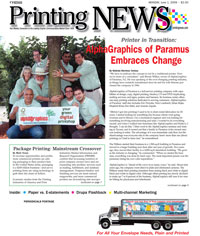|
  This article was quoted in the 2009 Drupa Report. This article was quoted in the 2009 Drupa Report.
Jun. 1, 2009— The past 12 months have been challenging, by almost any factor you choose to consider. It’s hard to believe that Drupa, the industry’s largest trade show, was only a year ago. So what happened to all the technology and promise on display in Germany last year? Printing News asked people from all around the industry that very question, and got some interesting answers. First and foremost, Drupa 2008 focused on inkjet and digital technologies. It was hyped at the time as the “inkjet Drupa,” but it’s only in hindsight that we can see how true that was.
“I was last there in 2000, and last year’s was much larger than I remembered,” said Lesley Wylie, global marketing manager for InfoPrint Solutions Co. “The main difference was the significant increase in the digital content. Not only in the number of vendors, hardware, software and solutions that were demonstrated, but also for the customers’ adoption of the technologies and their creative implementations.”
Bill Parker, CMO of GMC Software, agreed, noting that, “There were many new announcements from some major vendors. It highlighted the advances of digital production, and there was excitement within the digital community.”
Some of those technologies included new presses from HP and Xerox. HP’s inkjet web press got a lot of attention and interest and is still something anyone looking to bridge the gap between offset and digital a little more closely should be watching. And Xerox’s newest version in its iGen line, the iGen4, brought faster speeds and better quality, giving digital one more edge in an increasingly fast-paced world.
Putting it into Practice
But technology itself, while interesting and a lot of fun to watch in action at trade shows, is only a means to an end at the end of the day. It’s the applications, ultimately, that speak to digital’s increasing versatility. Around every corner, it seemed, there was something new to be amazed over. Some of the highlights included digitally printed food packaging, photo books personalized in almost every way imaginable, and even 3D models being printed on an inkjet machine.
“[One] thing I found myself referring back to time and again were the real-world digital printing applications on display—photo books, customized travel guides, even personalized packages of chewing gum,” said Tracy Yelencsics, vice president, Production Marketing Communications & Programs, Xerox. “It’s easy to get swept away by the glitz and glamour of all the new products, and it gets hard to sift through the barrage of information in such a short time. But applications are the language of our customers, and seeing those real jobs on display reminded me of why we were all there—to show attendees how to create these stunning and profitable print applications.”
Transpromo applications were another major force at Drupa 2008, demonstrating how the unassuming billing statement could become a powerful marketing and branding opportunity.
“Development of inkjet print solutions for the Transactional market [really stood out to me],” said Ronald van Hees, director of marketing, Pitney Bowes. “That, plus a high level of automation makes transpromo in reach for many customers.”
Transpromo isn’t a new technology—it’s been around and in the news for several years now. However, last year’s Drupa, as van Hees noted, brought the category to the next level, putting it within reach as a application to offer clients for many more shops with new machines and software geared at making the process faster and easier making their debut in Germany.
“I wouldn’t call it a product or technology per se, but the overall Transpromo solution, including the data analytics and campaign management components was the hottest topic in the digital area,” said Wylie. “Leveraging digital inkjet printers for transactional documents while reducing the total cost of print and saving paper are all key value-adds of Transpromo. In today’s economy, it seems like companies are continuing to see more and more benefits from this solution.”
A Changing Economy
It’s impossible to look back over the past year without also looking at the proverbial 800-pound gorilla: the economy. No one can deny the past six to 12 months have been difficult for every sector, and not just in the United States, but worldwide. Print, as a whole, has weathered the storm, but as always, there have been mergers and acquisitions, and shops that rocketed to the top while others sank to the bottom. And while things are starting to pick up, a full recovery, according to most economists, won’t be felt until well into 2010. So what does that mean for the technologies and solutions launched just 12 months ago at Drupa?
“I would say that some of the optimism and enthusiasm we all felt at the close of Drupa has waned a bit with the economic downturn, which hit first in the United States, and now is impacting businesses on a more global basis,” said Stacy West, digital publishing solutions marketing manager, North America, HP. “Overall, people became more cautious regarding capital expenditures. Fortunately, the digital value proposition is even more relevant in tough economic times, so we still see many prospects progressing through the sales cycle.”
Wylie agreed, noting, “The economic situation redirected everyone’s attention, and the focus became cost reductions, improved efficiencies and solutions to deal with compliance and new regulations.”
But it’s not all doom and gloom. In fact, Drupa and its offerings were one of the reasons the print industry has seen adaptations, but has not been hit as hard as some other sectors, noted Yelencsics. “I think Drupa jump started the industry again; it reinvigorated us. The economic challenges of the past year are certainly not behind us, but we’re seeing signs that the print industry is alive and well. I’m very proud of our industry’s ability to adapt. The reality of the market today is tight margins, fast turnaround, short runs and ever-increasing customer demands. Drupa introduced us to a wide range of technology and services that help print providers meet these demands, and position themselves to come out of this recession in a stronger position.”
Looking Ahead
So what’s in store for trade shows in the future? Given how fast people communicate these days, and how almost everything has been forever changed by the Internet, will trade shows continue to be relevant? The short answer is yes. The long answer is that while the reason for going to shows is changing, the need for gatherings such as Drupa 2008 are more important today than ever before.
“Now, people go to trade shows having carried out their own research on the Internet, so when they visit the trade show it is about people,” said Parker. “Visitors want to understand the culture and the people of prospective suppliers, looking for the confidence to do business.”
In other words, people want to evaluate who they’re doing business with. Sure, seeing the technology in action and getting demos of products they might have, to that point, only seen online, is incredibly valuable. But the ability to talk to people, to put faces with e-mail addresses and voices on the phone, remains a huge draw. Most small businesses can’t afford the time or money to travel to every vendor showroom to meet their people, but in one trip, they can make a point of speaking with nearly every company they do business with. This personal element just can’t be replaced with any technology available today.
When it’s all said and done, Drupa 2008 impacted the industry in many ways. The size and scope of offerings on display from almost every company worldwide that deals with print can’t help but have an effect. However, at the end of the day, it was the technologies and companies we’ll remember, not the show itself. Which is exactly what a good trade show should do.
|


